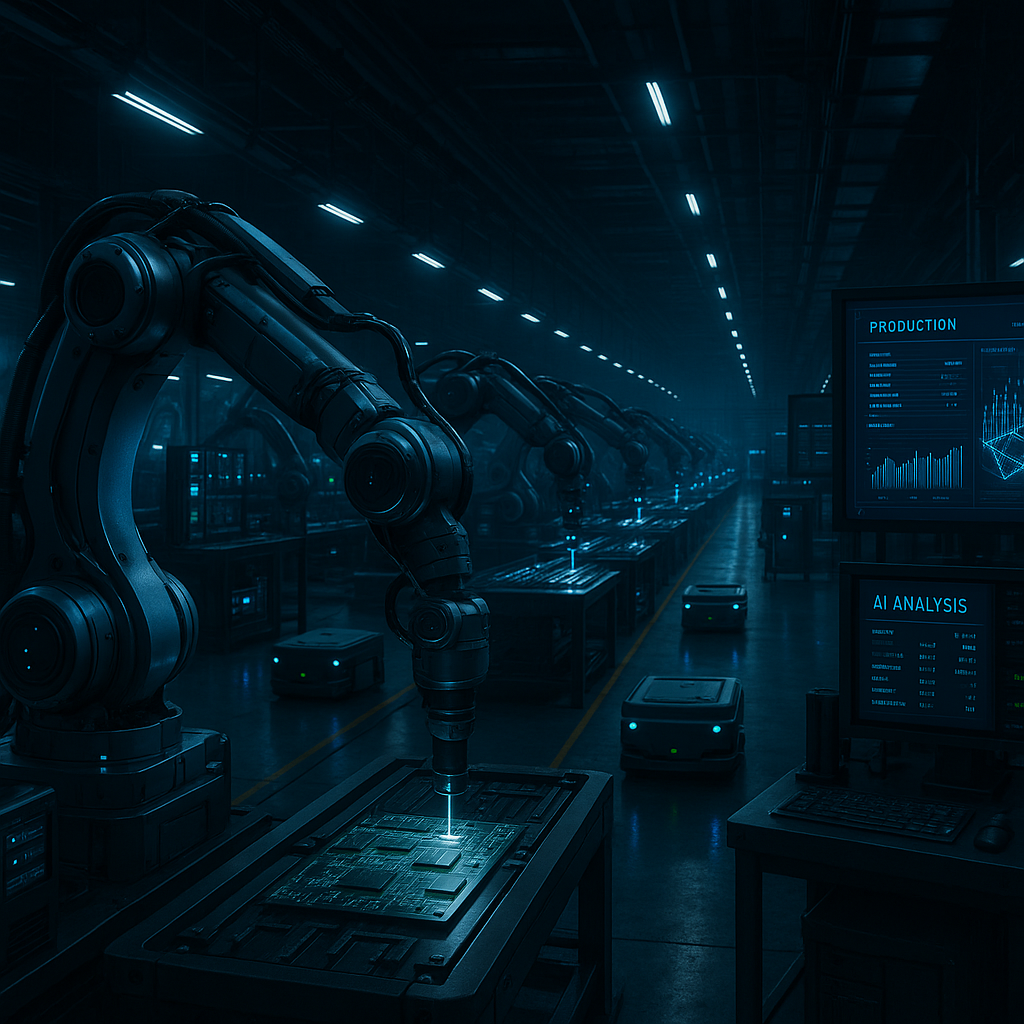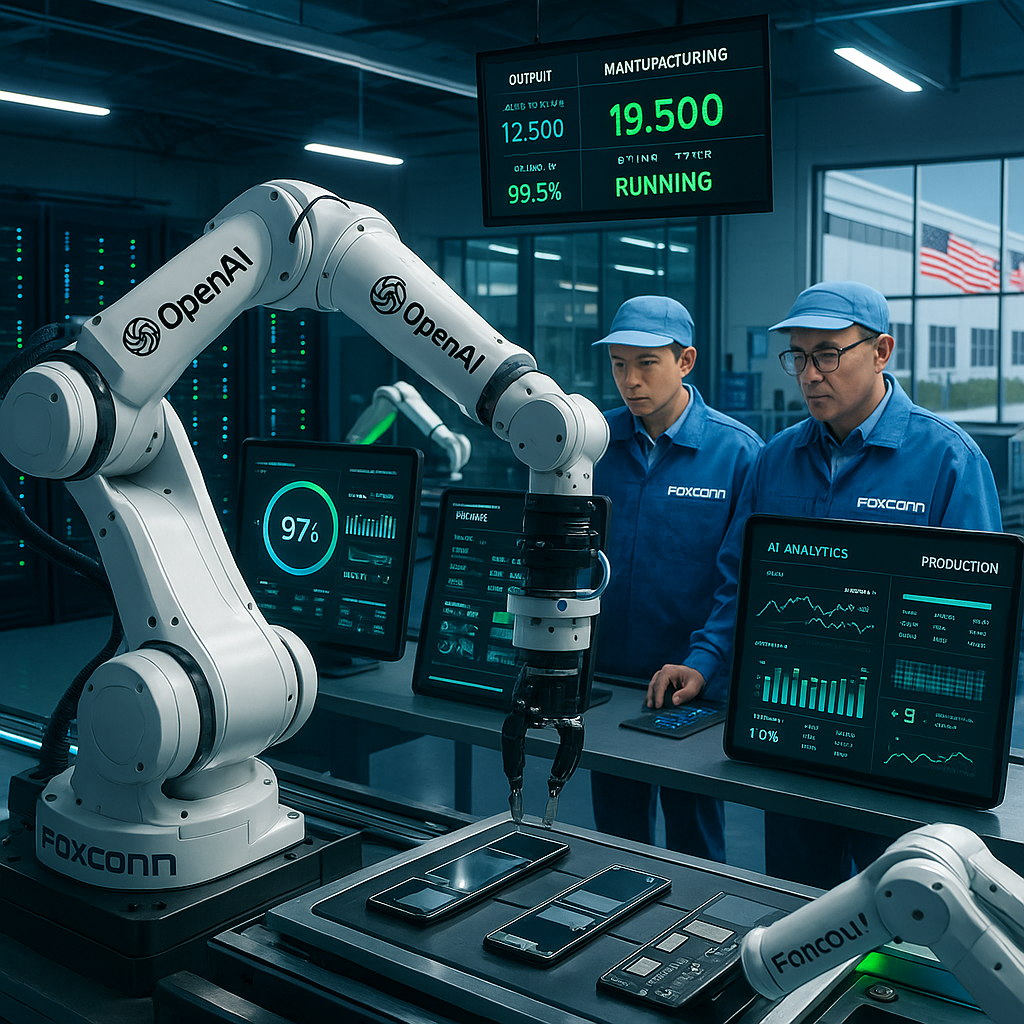Key Takeaways
- AI-driven robotics eliminate the need for human labor: Advanced robotics, combined with artificial intelligence, IoT, and machine vision, enable dark factories to operate around the clock without direct human intervention. This drives operational efficiency and provides flexibility across diverse manufacturing environments.
- Strategic investment underpins manufacturing dominance: China’s $1.4 billion investment in robotics R&D in 2023 signifies a calculated approach to counter rising domestic labor costs. It reinforces China’s pivotal role in global supply chains and cements its leadership within advanced manufacturing.
- Geopolitics shape the automation race: China’s assertive embrace of dark factory technology delivers far-reaching geopolitical consequences. As it redefines global trade flows, it challenges traditional manufacturing strongholds and compels other nations to accelerate their own automation agendas.
- Massive productivity and cost improvements reshape industry standards: The era of fully autonomous manufacturing dramatically reduces labor expenses, limits defects, and speeds up production cycles. These facilities establish new benchmarks for efficiency in sectors ranging from automotive and semiconductors to consumer electronics, pharmaceuticals, and consumer goods.
- Environmental impact shifts with energy-efficient automation: Dark factories leverage smart energy management, integrated AI controls, and advanced recycling systems, reducing waste, optimizing resource use, and minimizing carbon footprints. This is crucial for sustainable manufacturing as China advances its industrial modernization.
- Industry 4.0 becomes tangible on the factory floor: By fusing AI, big data analytics, machine connectivity, and digital twins, Chinese manufacturers transform traditional factories into smart, hyper-efficient ecosystems. This is ushering in a global manufacturing revolution.
- Reshaping the future workforce and supply chain resilience: The proliferation of unmanned factories is altering labor markets and supply chain strategies. There is a rising demand for tech-savvy roles such as robotics engineers, as well as increased resilience against disruptions from global events or geopolitical tensions.
Understanding the driving forces behind China’s dark factories reveals how technology, economics, and global power are now deeply intertwined. To fully grasp this transformation, we will delve into the enabling technologies, cross-industry impacts, and what businesses and policymakers must consider to adapt to this new manufacturing paradigm.
Introduction
Factories that operate tirelessly, guided entirely by artificial intelligence while machines hum in the shadows, are no longer the stuff of science fiction. China’s rapid deployment of “dark factories” is redefining manufacturing, with human labor giving way to fully autonomous lights-out production lines.
This leap forward is not merely a feat of engineering. It is a strategic maneuver with broad economic and geopolitical consequences. By investing billions in AI-powered robotics and end-to-end industrial automation, China is setting new global standards for efficiency, productivity, and environmental stewardship. All this is happening as the country rewrites the rules for workforce development and international supply chains.
Now, let us explore how China’s dark factories are fueling a revolutionary new era in manufacturing and what this means for stakeholders across industries and borders.
Un passo avanti. Sempre.
Unisciti al nostro canale Telegram per ricevere
aggiornamenti mirati, notizie selezionate e contenuti che fanno davvero la differenza.
Zero distrazioni, solo ciò che conta.
 Entra nel Canale
Entra nel Canale
The Evolution of Dark Factories in China
Definition and Core Concepts
Dark factories, also known as lights-out factories, epitomize the future of automated production. In these settings, manufacturing continues without interruption and with minimal human input. Thanks to sophisticated AI algorithms and state-of-the-art robotics, Chinese dark factories carry out complex operations even in complete darkness, as there is simply no need for human presence on the shop floor.
This evolution has its roots in policy, particularly the Made in China 2025 initiative. The government’s decisive push (underscored by a $1.4 billion commitment to robotics R&D in 2023) demonstrates a strategic intent to retain manufacturing preeminence even as labor costs and demographics shift. These investments accelerate the move from basic automation to smart factories where machines collaborate, learn, and update processes in real time.
Technological Infrastructure
AI and Machine Learning Systems
AI and machine learning form the foundation of dark factory operations. These tools handle a spectrum of tasks, from predictive maintenance and dynamic scheduling to real-time quality assurance. For example, at a leading Shenzhen electronics company, AI-powered logistics and inspection cut defects by 37%, while boosting annual throughput by 25%.
AI-powered logistics enables new levels of operational intelligence in these environments, with algorithmic optimization streamlining both production and material handling.
Robotics and Automation
Chinese lights-out facilities deploy multiple robotic platforms, each tailored to specific tasks:
- Autonomous Mobile Robots (AMRs) efficiently move raw materials and components.
- Collaborative robots (cobots) handle precision assembly, ensuring accuracy on micro and macro scales.
- Vision-guided robotic arms execute rapid, nuanced quality control across product lines.
- Smart conveyor and sorting systems optimize product flows and reduce manual handling.
IoT Integration and Digital Twin Technology
The Internet of Things (IoT) connects machines, sensors, and devices, creating a networked environment where every asset shares real-time operational data. Digital twin technology further augments this by offering live factory simulations. This two-way communication enables predictive maintenance, process optimization, and instant anomaly detection. In China’s most advanced sites, downtime is almost cut in half.
IoT connects machines in ways that amplify efficiency and provide actionable, real-time feedback across massive industrial footprints.
Economic Impact and Performance Metrics
Productivity and Efficiency Gains
Across China, dark factories deliver impressive operational metrics:
- Up to 85% reduction in production errors
- Production capacity increases of 200% to 300%
- Energy usage declines of nearly 67%
- Quality control costs slashed by as much as 92%
These efficiencies are not limited to electronics or automotive production. In sectors such as pharmaceuticals, apparel, and food processing, autonomous systems improve yield, support regulatory compliance, and accelerate time-to-market for new products.
Cost Analysis and ROI
Despite considerable upfront costs (ranging from $50 million to $200 million based on facility complexity), automation pays for itself rapidly. Chinese manufacturers recoup expenses within three to five years thanks to:
- Labor savings of 60% to 80%
- Lower energy and resource consumption
- Accelerated throughput and higher consistency
- Reduced waste and error mitigation
Banks and financial institutions increasingly track these KPIs, influencing lending decisions and shaping industry investment cycles.
Environmental Sustainability
Energy Efficiency
Dark factories in China excel at managing energy with precision through:
- Smart lighting that operates only during essential maintenance
- Advanced temperature and humidity controls led by AI
- Resource allocation algorithms that minimize waste
- Optimized HVAC (heating, ventilation, and air conditioning) scheduling based on real-time occupancy and usage data
Smart lighting and automated building management solutions are increasingly critical for both residential and industrial energy optimization.
Waste Reduction
By deploying advanced automation, lights-out factories achieve nearly zero waste through:
- AI-driven calculations for exact material requirements
- Automated recycling and repurposing lines for scrap and off-spec items
- Real-time monitoring to identify process inefficiencies instantly
- Preventative quality assurance, lowering the rejection rate for finished products
Beyond industrial applications, this model informs sustainability improvements in consumer electronics and even agriculture, where autonomous precision farming mirrors the resource efficiency seen in manufacturing.
Social and Economic Implications
Workforce Transformation
The spread of unmanned factories is transforming China’s labor market dynamics:
Un passo avanti. Sempre.
Unisciti al nostro canale Telegram per ricevere
aggiornamenti mirati, notizie selezionate e contenuti che fanno davvero la differenza.
Zero distrazioni, solo ciò che conta.
 Entra nel Canale
Entra nel Canale
- Creation of high-skilled roles focused on AI, software engineering, and robotics maintenance
- Increased demand for data scientists and system integrators
- Partnerships between industry and education to re-skill workers for technical fields
- Shifting human roles toward innovation, oversight, and system optimization rather than repetitive manual labor
Shifting human roles towards design, oversight, and system-level innovation is a natural extension of digital transformation across industries.
This change extends to sectors such as healthcare (for medical device assembly), legal firms (for compliance automation), and education (where new curricula emphasize digital skills).
Global Competitiveness
China’s leadership in automated manufacturing brings several strategic advantages:
- Elevated quality standards that meet or exceed international benchmarks
- Enhanced flexibility in responding to shifting market demand or external shocks
- Significantly reduced vulnerability to labor shortages or wage inflation
- Strengthened capacity for technological independence, encouraging local suppliers and innovation
Similar advancements are being monitored and adapted by industries worldwide, including financial services (for anti-fraud systems) and logistics (for inventory and fulfillment).
Implementation Challenges and Solutions
Technical Challenges
Widespread adoption of dark factories is not without hurdles:
- Integration of disparate hardware and software platforms
- Heightened cybersecurity risks, including industrial espionage and system sabotage
- Proactive system upkeep and regular software upgrades to prevent obsolescence
- Ensuring long-term interoperability as standards evolve
Solution Strategies
To overcome these obstacles, successful organizations adopt:
- Incremental, phased deployments to address bottlenecks without disrupting operations
- Comprehensive employee re-training programs that blend technical and soft skills
- Multi-layered cybersecurity systems with real-time monitoring and rapid response protocols
- Collaborative partnerships with technology leaders for ongoing access to expert support and upgrades
These solutions are increasingly replicated in other industries such as finance (for risk monitoring), healthcare (for secure patient data management), and retail (for omnichannel fulfillment).
Future Outlook and Industry Trends
Expansion Plans
China’s automated manufacturing footprint is growing rapidly:
- Projected 50% increase in dark factory deployments by 2025
- Targeting advanced fields like semiconductors, electric vehicles, and biotechnology
- Incorporating 5G wireless, edge computing, and AI-powered supply chain networks
- Leveraging global best practices to stay ahead of evolving international standards
5G wireless and next-generation connectivity are accelerating the evolution of industrial and consumer tech landscapes alike.
Technological Advancements
The next wave of dark factories will be shaped by:
- Quantum computing, improving optimization and data analysis
- Advanced materials handling robotics for ultra-precise manufacturing
- Self-healing machinery capable of automated repairs
- Blockchain-enabled systems for tamper-proof product tracking and quality assurance
Blockchain-enabled systems are emerging as vital tools for ensuring authenticity and transparency in modern manufacturing supply chains.
These trends are equally relevant in sectors such as environmental science (for real-time pollution controls), legal and compliance (for automated contract management), and retail (for dynamic inventory smarter than today’s systems).
Conclusion
China’s rapid embrace of dark factories heralds a transformative epoch for global manufacturing, where artificial intelligence, robotics, and hyper-connected infrastructure operate as the new industrial backbone. This bold leap delivers measurable gains: dramatic error reduction, lower operating costs, and improvements in energy efficiency and sustainability.
Yet the implications reach far beyond the shop floor. A profound re-skilling of the workforce, enhanced supply chain resilience, and the emergence of new strategic risks and opportunities all mark this new industrial age.
Looking forward, the true measure of success will not be the adoption of automation alone but the agility with which businesses and nations adapt to this relentless pace of innovation. Across industries, from healthcare to finance, education to retail, organizations that prioritize adaptability, invest in next-generation skills, and harness the full spectrum of intelligent automation will define the future. The real question isn’t whether these advancements will reshape the manufacturing world, but how energetically companies and policymakers will respond to claim their competitive edge.





Leave a Reply